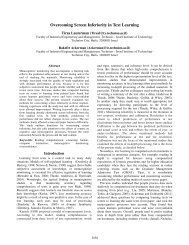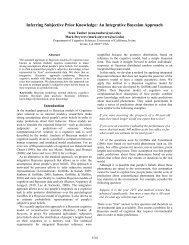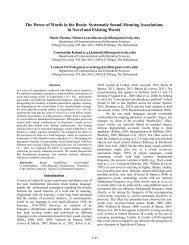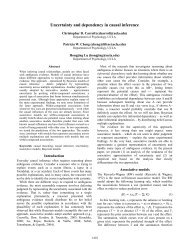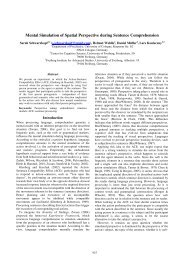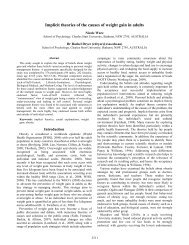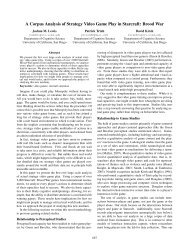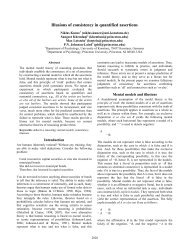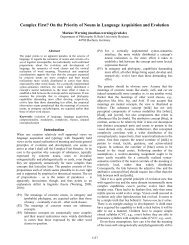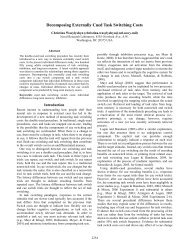influence of grammatical gender on deductive reasoning ... - IFVLL
influence of grammatical gender on deductive reasoning ... - IFVLL
influence of grammatical gender on deductive reasoning ... - IFVLL
You also want an ePaper? Increase the reach of your titles
YUMPU automatically turns print PDFs into web optimized ePapers that Google loves.
INFLUENCE OF GRAMMATICAL GENDER ON DEDUCTIVE REASONING<br />
ABOUT SEX-SPECIFIC PROPERTIES OF ANIMALS<br />
Mutsumi Imai (imai@sfc.keio.ac.jp)<br />
Faculty <str<strong>on</strong>g>of</str<strong>on</strong>g> Envir<strong>on</strong>ment and Informati<strong>on</strong> Studies, Keio University at Sh<strong>on</strong>an-Fujisawa, Japan<br />
Abstract<br />
Grammatical <str<strong>on</strong>g>gender</str<strong>on</strong>g> is independent <str<strong>on</strong>g>of</str<strong>on</strong>g> biological sex for the<br />
majority <str<strong>on</strong>g>of</str<strong>on</strong>g> animal names (e.g., a male giraffe is<br />
<str<strong>on</strong>g>grammatical</str<strong>on</strong>g>ly treated as feminine). However, there is<br />
apparent semantic motivati<strong>on</strong> for <str<strong>on</strong>g>grammatical</str<strong>on</strong>g> <str<strong>on</strong>g>gender</str<strong>on</strong>g> classes,<br />
especially in mapping human terms to <str<strong>on</strong>g>gender</str<strong>on</strong>g> classes. This<br />
research investigated whether this apparent motivati<strong>on</strong> in<br />
mapping between grammar and biological sex affects<br />
<strong>deductive</strong> inference in German speakers. We identified two<br />
c<strong>on</strong>texts in which speakers unc<strong>on</strong>sciously over-generalize the<br />
grammar-semantics mapping to make inappropriate <strong>deductive</strong><br />
inferences about sex-specific biological properties. They<br />
tended to err<strong>on</strong>eously accept deducti<strong>on</strong>s when the sex in the<br />
premise and the <str<strong>on</strong>g>grammatical</str<strong>on</strong>g> <str<strong>on</strong>g>gender</str<strong>on</strong>g> <str<strong>on</strong>g>of</str<strong>on</strong>g> the target animal<br />
agreed. The sex-<str<strong>on</strong>g>gender</str<strong>on</strong>g> agreement affected the inference<br />
even when the sex <str<strong>on</strong>g>of</str<strong>on</strong>g> the target was explicitly indicated (e.g.,<br />
die [FEM] männliche (male) Giraffe). Experiment 2 further<br />
suggested that these effects occur <strong>on</strong>ly when the <str<strong>on</strong>g>gender</str<strong>on</strong>g>marking<br />
article accompanied the noun. Implicati<strong>on</strong>s <str<strong>on</strong>g>of</str<strong>on</strong>g> the<br />
results for lintuistic relativity is discussed.<br />
Keywords: Add your choice <str<strong>on</strong>g>of</str<strong>on</strong>g> indexing terms or keywords;<br />
kindly use a semi-col<strong>on</strong>; between each term.<br />
Introducti<strong>on</strong><br />
Many languages <str<strong>on</strong>g>of</str<strong>on</strong>g> the world have a system <str<strong>on</strong>g>of</str<strong>on</strong>g><br />
<str<strong>on</strong>g>grammatical</str<strong>on</strong>g> <str<strong>on</strong>g>gender</str<strong>on</strong>g>, where nouns are assigned to <strong>on</strong>e <str<strong>on</strong>g>of</str<strong>on</strong>g> the<br />
limited number <str<strong>on</strong>g>of</str<strong>on</strong>g> <str<strong>on</strong>g>gender</str<strong>on</strong>g> classes (Corbett & Fraser, 2000).<br />
Unlike languages that mark <str<strong>on</strong>g>gender</str<strong>on</strong>g> <strong>on</strong>ly semantically (e.g.,<br />
English), languages with <str<strong>on</strong>g>grammatical</str<strong>on</strong>g> <str<strong>on</strong>g>gender</str<strong>on</strong>g> assign <str<strong>on</strong>g>gender</str<strong>on</strong>g><br />
to all nouns regardless <str<strong>on</strong>g>of</str<strong>on</strong>g> whether or not referents have a<br />
biological sex. The link between <str<strong>on</strong>g>gender</str<strong>on</strong>g> assignment and<br />
c<strong>on</strong>ceptual properties <str<strong>on</strong>g>of</str<strong>on</strong>g> n<strong>on</strong>-human referents has widely<br />
been said to be arbitrary (Aikhenvald, 2000; Fox, 1990), as<br />
<str<strong>on</strong>g>grammatical</str<strong>on</strong>g> <str<strong>on</strong>g>gender</str<strong>on</strong>g> is not relevant to biological sex for a<br />
majority <str<strong>on</strong>g>of</str<strong>on</strong>g> words. For example, in German, the word<br />
giraffe is <str<strong>on</strong>g>grammatical</str<strong>on</strong>g>ly feminine and elephant is masculine,<br />
but it is not the case that all giraffes are female or that all<br />
elephants are male. N<strong>on</strong>etheless, the feminine article die<br />
([FEM]) must be applied when <strong>on</strong>e refers to a <str<strong>on</strong>g>grammatical</str<strong>on</strong>g>ly<br />
feminine noun and the feminine pr<strong>on</strong>oun sie must be used as<br />
an anaphoric reference, whether the referent is biologically<br />
female or male (e.g., die männliche (male) Giraffe). Here,<br />
Lennart Schalk (schalk@ifv.gess.ethz.ch)<br />
Institute for Behavioral Sciences, ETH Zurich, Switzerland<br />
Henrik Saalbach (saalbach@ifv.gess.ethz.ch)<br />
Institute for Behavioral Sciences, ETH Zurich, Switzerland<br />
Hiroyuki Okada (h.okada@eng.tamagawa.ac.jp)<br />
Department <str<strong>on</strong>g>of</str<strong>on</strong>g> Engineering, Tamagawa University, Japan<br />
an interesting questi<strong>on</strong> is to what extent speakers are able to<br />
separate the biological sex <str<strong>on</strong>g>of</str<strong>on</strong>g> an animal from its<br />
<str<strong>on</strong>g>grammatical</str<strong>on</strong>g> <str<strong>on</strong>g>gender</str<strong>on</strong>g>. From the perspective <str<strong>on</strong>g>of</str<strong>on</strong>g> a speaker <str<strong>on</strong>g>of</str<strong>on</strong>g><br />
language without <str<strong>on</strong>g>grammatical</str<strong>on</strong>g> <str<strong>on</strong>g>gender</str<strong>on</strong>g>, it appears c<strong>on</strong>fusing<br />
that <strong>on</strong>e has to use the feminine article and the female<br />
pr<strong>on</strong>oun even when the giraffe is actually male. Of course,<br />
speakers <str<strong>on</strong>g>of</str<strong>on</strong>g> a language with the <str<strong>on</strong>g>grammatical</str<strong>on</strong>g> <str<strong>on</strong>g>gender</str<strong>on</strong>g> system<br />
must know that <str<strong>on</strong>g>grammatical</str<strong>on</strong>g> <str<strong>on</strong>g>gender</str<strong>on</strong>g> does not directly reflect<br />
biological sex. However, are the speakers completely<br />
immune to the <str<strong>on</strong>g>influence</str<strong>on</strong>g> <str<strong>on</strong>g>of</str<strong>on</strong>g> <str<strong>on</strong>g>grammatical</str<strong>on</strong>g> <str<strong>on</strong>g>gender</str<strong>on</strong>g> when they<br />
draw inferences about the animal’s sex-specific biological<br />
properties? It is possible that the few cases <str<strong>on</strong>g>of</str<strong>on</strong>g> semantic<br />
corresp<strong>on</strong>dence between <str<strong>on</strong>g>grammatical</str<strong>on</strong>g> <str<strong>on</strong>g>gender</str<strong>on</strong>g> and biological<br />
sex may have resulted in an overgeneralizati<strong>on</strong> during the<br />
process <str<strong>on</strong>g>of</str<strong>on</strong>g> language acquisiti<strong>on</strong>. In German, for example,<br />
salient female terms such as woman, lady, mother are<br />
<str<strong>on</strong>g>grammatical</str<strong>on</strong>g>ly feminine, while salient male terms such as<br />
man, boy, father, are <str<strong>on</strong>g>grammatical</str<strong>on</strong>g>ly masculine (Natural Sex<br />
Principle, cf. Zubin & Koepcke, 1986).<br />
Thus, speakers may falsely generalize this excepti<strong>on</strong>al<br />
mapping between <str<strong>on</strong>g>gender</str<strong>on</strong>g> class and biological sex to words<br />
for animated entities in general. This assumpti<strong>on</strong> is<br />
c<strong>on</strong>sistent with Vigliocco and colleagues’ (Vigliocco,<br />
Vins<strong>on</strong>, Paganelli, & Dworzynski, 2005) sex-and-<str<strong>on</strong>g>gender</str<strong>on</strong>g>hypothesis,<br />
which proposes that a c<strong>on</strong>ceptual <str<strong>on</strong>g>influence</str<strong>on</strong>g> <str<strong>on</strong>g>of</str<strong>on</strong>g><br />
<str<strong>on</strong>g>grammatical</str<strong>on</strong>g> <str<strong>on</strong>g>gender</str<strong>on</strong>g> originates in speakers’ first noticing the<br />
corresp<strong>on</strong>dence between <str<strong>on</strong>g>grammatical</str<strong>on</strong>g> classes and<br />
corresp<strong>on</strong>ding c<strong>on</strong>ceptual classes. In other words,<br />
acknowledging the link between biological sex and the<br />
<str<strong>on</strong>g>grammatical</str<strong>on</strong>g> <str<strong>on</strong>g>gender</str<strong>on</strong>g> class in the case <str<strong>on</strong>g>of</str<strong>on</strong>g> some salient humanspecific<br />
terms leads speakers to develop a general<br />
anticipati<strong>on</strong> that even n<strong>on</strong>-human animals from the same<br />
<str<strong>on</strong>g>grammatical</str<strong>on</strong>g> <str<strong>on</strong>g>gender</str<strong>on</strong>g> class are more similar to <strong>on</strong>e another<br />
than animals from different <str<strong>on</strong>g>grammatical</str<strong>on</strong>g> <str<strong>on</strong>g>gender</str<strong>on</strong>g> classes.<br />
Most <str<strong>on</strong>g>of</str<strong>on</strong>g> the previous research has asked whether and to<br />
what extent <str<strong>on</strong>g>grammatical</str<strong>on</strong>g> <str<strong>on</strong>g>gender</str<strong>on</strong>g> <str<strong>on</strong>g>influence</str<strong>on</strong>g>s speakers’<br />
c<strong>on</strong>cepts <str<strong>on</strong>g>of</str<strong>on</strong>g> entities in terms <str<strong>on</strong>g>of</str<strong>on</strong>g> typically feminine/masculine<br />
attributes assigned to those entities. K<strong>on</strong>ishi (1993) looked<br />
at how Spanish and German speakers c<strong>on</strong>strue femininity or<br />
masculinity <str<strong>on</strong>g>of</str<strong>on</strong>g> n<strong>on</strong>-animal objects by having them give<br />
<str<strong>on</strong>g>gender</str<strong>on</strong>g>-related ratings <str<strong>on</strong>g>of</str<strong>on</strong>g> various nouns <strong>on</strong> a potency scale<br />
1160
(e.g., weak vs. str<strong>on</strong>g; tender vs. vigorous): German<br />
speakers rated mo<strong>on</strong> (<str<strong>on</strong>g>grammatical</str<strong>on</strong>g>ly masculine in German<br />
and feminine in Spanish) to be higher <strong>on</strong> the scale <str<strong>on</strong>g>of</str<strong>on</strong>g><br />
masculinity than sun (masculine in Spanish and feminine in<br />
German), while Spanish speakers showed the reverse<br />
pattern. Sera and colleagues (Sera, Berge, & del Castillo<br />
Pintado, 1994; Sera, Elieff, Forbes, Burch, Rodriguez, &<br />
Dubois, 2002) asked Spanish and French speakers to assign<br />
either a female or a male voice to artifact objects and<br />
reported that the judgments tended to agree with the<br />
<str<strong>on</strong>g>grammatical</str<strong>on</strong>g> <str<strong>on</strong>g>gender</str<strong>on</strong>g> <str<strong>on</strong>g>of</str<strong>on</strong>g> the objects (see also Boroditsky,<br />
Schmidt, & Phillips, 2003; Flaherty, 2001). However, to<br />
our knowledge, the questi<strong>on</strong> <str<strong>on</strong>g>of</str<strong>on</strong>g> whether speakers <str<strong>on</strong>g>of</str<strong>on</strong>g> a<br />
language with <str<strong>on</strong>g>grammatical</str<strong>on</strong>g> <str<strong>on</strong>g>gender</str<strong>on</strong>g> are at all <str<strong>on</strong>g>influence</str<strong>on</strong>g>d by<br />
<str<strong>on</strong>g>grammatical</str<strong>on</strong>g> <str<strong>on</strong>g>gender</str<strong>on</strong>g> when they make inferences about<br />
biological sex-specific properties <str<strong>on</strong>g>of</str<strong>on</strong>g> animals has not been<br />
addressed in the literature.<br />
Importantly, Vigliocco et al. (2005) suggested that the<br />
relati<strong>on</strong> between <str<strong>on</strong>g>grammatical</str<strong>on</strong>g> <str<strong>on</strong>g>gender</str<strong>on</strong>g> and speakers’<br />
c<strong>on</strong>cepts is weaker for languages with more than two <str<strong>on</strong>g>gender</str<strong>on</strong>g><br />
classes, such as German. Using an odd-<strong>on</strong>e-out<br />
categorizati<strong>on</strong> task, they in fact found an effect <str<strong>on</strong>g>of</str<strong>on</strong>g><br />
<str<strong>on</strong>g>grammatical</str<strong>on</strong>g> <str<strong>on</strong>g>gender</str<strong>on</strong>g> <strong>on</strong> Italian speakers’ c<strong>on</strong>strual <str<strong>on</strong>g>of</str<strong>on</strong>g><br />
similarity am<strong>on</strong>g animals, but not <strong>on</strong> German speakers’.<br />
However, unlike judgments <str<strong>on</strong>g>of</str<strong>on</strong>g> abstract similarity am<strong>on</strong>g<br />
objects, inference about biological sex-specific properties is<br />
more directly linked to <str<strong>on</strong>g>grammatical</str<strong>on</strong>g> <str<strong>on</strong>g>gender</str<strong>on</strong>g> categories, and<br />
hence we might expect the <str<strong>on</strong>g>influence</str<strong>on</strong>g> <str<strong>on</strong>g>of</str<strong>on</strong>g> <str<strong>on</strong>g>grammatical</str<strong>on</strong>g> <str<strong>on</strong>g>gender</str<strong>on</strong>g><br />
in German speakers in this case.<br />
It is hard to imagine that German speakers are not aware<br />
<str<strong>on</strong>g>of</str<strong>on</strong>g> the motivated link between <str<strong>on</strong>g>grammatical</str<strong>on</strong>g> <str<strong>on</strong>g>gender</str<strong>on</strong>g> and<br />
biological sex, as human males are clearly mapped to the<br />
masculine <str<strong>on</strong>g>gender</str<strong>on</strong>g> and human females are mapped to the<br />
feminine <str<strong>on</strong>g>gender</str<strong>on</strong>g>. Yet, when thinking about animals at the<br />
level <str<strong>on</strong>g>of</str<strong>on</strong>g> generic species (dog, cat, giraffe, etc.), speakers<br />
have to separate <str<strong>on</strong>g>grammatical</str<strong>on</strong>g> <str<strong>on</strong>g>gender</str<strong>on</strong>g> and biological sex. Of<br />
course, adults speaking a language with <str<strong>on</strong>g>grammatical</str<strong>on</strong>g> <str<strong>on</strong>g>gender</str<strong>on</strong>g><br />
must c<strong>on</strong>sciously understand that <str<strong>on</strong>g>grammatical</str<strong>on</strong>g> <str<strong>on</strong>g>gender</str<strong>on</strong>g> <str<strong>on</strong>g>of</str<strong>on</strong>g><br />
basic-level animal names is independent <str<strong>on</strong>g>of</str<strong>on</strong>g> animals’<br />
biological sex. However, it may still be possible that their<br />
inference is still affected by the overgeneralizati<strong>on</strong> <str<strong>on</strong>g>of</str<strong>on</strong>g> the<br />
syntax-semantics mappings: For example, they may make a<br />
false <strong>deductive</strong> c<strong>on</strong>clusi<strong>on</strong> that <str<strong>on</strong>g>grammatical</str<strong>on</strong>g>ly feminine (or<br />
masculine) animals in general have a female (or male)specific<br />
biological property.<br />
Deductive reas<strong>on</strong>ing plays a core role in human inference<br />
and learning, al<strong>on</strong>g with inductive reas<strong>on</strong>ing (cf. Murphy,<br />
2002). If <str<strong>on</strong>g>grammatical</str<strong>on</strong>g> <str<strong>on</strong>g>gender</str<strong>on</strong>g> affects <strong>deductive</strong> reas<strong>on</strong>ing<br />
about biological properties even though people c<strong>on</strong>sciously<br />
understand that <str<strong>on</strong>g>grammatical</str<strong>on</strong>g> <str<strong>on</strong>g>gender</str<strong>on</strong>g> is independent <str<strong>on</strong>g>of</str<strong>on</strong>g><br />
biological sex <str<strong>on</strong>g>of</str<strong>on</strong>g> animals, this will be taken as support for<br />
linguistic relativity.<br />
Provided that such an effect is seen, however, it is<br />
important to be able to distinguish two possible mechanisms<br />
behind it. The effect may arise within the realm <str<strong>on</strong>g>of</str<strong>on</strong>g> syntactic<br />
processing but not at the c<strong>on</strong>ceptual representati<strong>on</strong> <str<strong>on</strong>g>of</str<strong>on</strong>g><br />
animal kinds. In other words, the effect may be seen <strong>on</strong>ly<br />
when a speaker processes the <str<strong>on</strong>g>gender</str<strong>on</strong>g>-marking article or<br />
pr<strong>on</strong>oun. The alternative possibility is that the overgeneralized<br />
syntax-semantic mapping penetrates into the<br />
c<strong>on</strong>ceptual level <str<strong>on</strong>g>of</str<strong>on</strong>g> generic-level animal kinds. If this is the<br />
case, the effect should be seen even when generic-level<br />
animal names are presented without the <str<strong>on</strong>g>gender</str<strong>on</strong>g>-marking<br />
article.<br />
The present study<br />
We tested German and Japanese speakers <strong>on</strong> <strong>deductive</strong><br />
inferences about sex-specific animal properties. The<br />
Japanese speakers’ performance served as a baseline<br />
because Japanese is a language without <str<strong>on</strong>g>grammatical</str<strong>on</strong>g> <str<strong>on</strong>g>gender</str<strong>on</strong>g>.<br />
We designed two experiments in such a way that we could<br />
identify at what level <str<strong>on</strong>g>of</str<strong>on</strong>g> processing the relati<strong>on</strong> between<br />
<str<strong>on</strong>g>grammatical</str<strong>on</strong>g> <str<strong>on</strong>g>gender</str<strong>on</strong>g> and <strong>deductive</strong> reas<strong>on</strong>ing is found, if it is<br />
found at all. In the first experiment, target words for<br />
deducti<strong>on</strong> were presented in the singular form with their<br />
associated articles marking the <str<strong>on</strong>g>gender</str<strong>on</strong>g> class <str<strong>on</strong>g>of</str<strong>on</strong>g> each word.<br />
(In German, article + noun phrase can refer to a generic<br />
meaning.) In the sec<strong>on</strong>d experiment, the target words were<br />
presented in plural form without any marking <str<strong>on</strong>g>of</str<strong>on</strong>g> <str<strong>on</strong>g>gender</str<strong>on</strong>g><br />
class. Participants were asked to indicate whether the<br />
<strong>deductive</strong> c<strong>on</strong>clusi<strong>on</strong> would hold true or not; they were<br />
instructed to give a “No” resp<strong>on</strong>se in cases in which the<br />
c<strong>on</strong>clusi<strong>on</strong> was logically indeterminable, in additi<strong>on</strong> to the<br />
cases in which deducti<strong>on</strong> would be clearly false.<br />
Five c<strong>on</strong>diti<strong>on</strong>s were set up within participants. The<br />
Generic Animal C<strong>on</strong>diti<strong>on</strong> was designed to test whether<br />
German speakers were more likely to draw a err<strong>on</strong>eous<br />
<strong>deductive</strong> c<strong>on</strong>clusi<strong>on</strong> when the sex specified for the<br />
biological property given in the premise and the<br />
<str<strong>on</strong>g>grammatical</str<strong>on</strong>g> <str<strong>on</strong>g>gender</str<strong>on</strong>g> class <str<strong>on</strong>g>of</str<strong>on</strong>g> the target animal’s basic-level<br />
name were c<strong>on</strong>sistent (e.g., female – feminine) than when<br />
they were inc<strong>on</strong>sistent (e.g., female – masculine). Here, the<br />
<strong>deductive</strong> c<strong>on</strong>clusi<strong>on</strong> is logically indeterminable, as the<br />
biological sex <str<strong>on</strong>g>of</str<strong>on</strong>g> the target animal is unknown, and thus,<br />
“No” is the correct answer. Nevertheless, German speakers<br />
may experience difficulties rejecting the <strong>deductive</strong><br />
c<strong>on</strong>clusi<strong>on</strong> when the <str<strong>on</strong>g>grammatical</str<strong>on</strong>g> <str<strong>on</strong>g>gender</str<strong>on</strong>g> <str<strong>on</strong>g>of</str<strong>on</strong>g> the target<br />
animal agrees with the biological sex specified in the<br />
premise. In c<strong>on</strong>trast, it should be easy for Japanese speakers<br />
to reject the deducti<strong>on</strong> in this ambiguous case.<br />
In order to test for possible baseline differences in<br />
<strong>deductive</strong> reas<strong>on</strong>ing across the two language groups, we<br />
included the Generic-Animal C<strong>on</strong>trol C<strong>on</strong>diti<strong>on</strong>. Here,<br />
participants were to judge the correctness <str<strong>on</strong>g>of</str<strong>on</strong>g> the <strong>deductive</strong><br />
c<strong>on</strong>clusi<strong>on</strong> about a property true for all animals regardless<br />
<str<strong>on</strong>g>of</str<strong>on</strong>g> their sex, while the targets were exactly the same as in the<br />
Generic-Animal c<strong>on</strong>diti<strong>on</strong>.<br />
The Sex-specified Animal C<strong>on</strong>diti<strong>on</strong> was set up to test<br />
whether <str<strong>on</strong>g>grammatical</str<strong>on</strong>g> <str<strong>on</strong>g>gender</str<strong>on</strong>g> affects <strong>deductive</strong> inference in<br />
German speakers even when the sex <str<strong>on</strong>g>of</str<strong>on</strong>g> the animal is<br />
explicitly specified in the c<strong>on</strong>clusi<strong>on</strong>. Here, unlike the<br />
Generic Animal c<strong>on</strong>diti<strong>on</strong>, the target animal’s sex was<br />
explicitly specified by the <str<strong>on</strong>g>gender</str<strong>on</strong>g>-specifying adjective and<br />
the specified sex and the <str<strong>on</strong>g>grammatical</str<strong>on</strong>g> <str<strong>on</strong>g>gender</str<strong>on</strong>g> <str<strong>on</strong>g>of</str<strong>on</strong>g> the target<br />
1161
animal was either c<strong>on</strong>sistent or inc<strong>on</strong>sistent. Here, the<br />
<strong>deductive</strong> inference should <str<strong>on</strong>g>of</str<strong>on</strong>g> course be made based <strong>on</strong> the<br />
agreement between the sex in the premise and the target<br />
animal’s sex indicated by the adjective. It is interesting to<br />
see if c<strong>on</strong>sistency between <str<strong>on</strong>g>grammatical</str<strong>on</strong>g> <str<strong>on</strong>g>gender</str<strong>on</strong>g> and sex<br />
affects German speakers’ judgments in this obvious case.<br />
The Sex-specified Animal C<strong>on</strong>trol C<strong>on</strong>diti<strong>on</strong> was included<br />
to rule out an alternative explanati<strong>on</strong> for the potential<br />
<str<strong>on</strong>g>gender</str<strong>on</strong>g> effect in the Sex-specified Animal C<strong>on</strong>diti<strong>on</strong>.<br />
Provided that the expected effect was obtained, it may also<br />
have arisen from the difference in the difficulty in simply<br />
processing <str<strong>on</strong>g>of</str<strong>on</strong>g> the two types <str<strong>on</strong>g>of</str<strong>on</strong>g> (i.e., <str<strong>on</strong>g>grammatical</str<strong>on</strong>g> <str<strong>on</strong>g>gender</str<strong>on</strong>g>-sex<br />
specifying adjective matching and mismatching) noun<br />
phrases. To disambiguate the two possibilities, the<br />
c<strong>on</strong>clusi<strong>on</strong>s in this c<strong>on</strong>diti<strong>on</strong> were the same as those in the<br />
Sex-specified Animal C<strong>on</strong>diti<strong>on</strong>, but the property in the<br />
premise was not sex-specific. Finding the <str<strong>on</strong>g>gender</str<strong>on</strong>g> effect in<br />
German speakers in this c<strong>on</strong>trol c<strong>on</strong>diti<strong>on</strong> would indicate<br />
that the effect arises at the level <str<strong>on</strong>g>of</str<strong>on</strong>g> local phrase processing<br />
rather than during the <strong>deductive</strong> reas<strong>on</strong>ing. In c<strong>on</strong>trast, if<br />
there is no <str<strong>on</strong>g>gender</str<strong>on</strong>g> effect in this c<strong>on</strong>trol c<strong>on</strong>diti<strong>on</strong>, but the<br />
effect is found in the Sex-specified Animal c<strong>on</strong>diti<strong>on</strong>, where<br />
the property in the premise is also sex-specific, this suggests<br />
that the <str<strong>on</strong>g>grammatical</str<strong>on</strong>g> <str<strong>on</strong>g>gender</str<strong>on</strong>g> affects <strong>deductive</strong> reas<strong>on</strong>ing<br />
about a sex-specific property, even when the target animal’s<br />
sex is explicitly given.<br />
Finally, the Artifact C<strong>on</strong>diti<strong>on</strong> was included to examine<br />
whether German speakers’ <strong>deductive</strong> reas<strong>on</strong>ing about n<strong>on</strong>animate<br />
entities was affected by <str<strong>on</strong>g>grammatical</str<strong>on</strong>g> <str<strong>on</strong>g>gender</str<strong>on</strong>g>. The<br />
target object was an artifact whose <str<strong>on</strong>g>grammatical</str<strong>on</strong>g> <str<strong>on</strong>g>gender</str<strong>on</strong>g> was<br />
either c<strong>on</strong>sistent or inc<strong>on</strong>sistent with the sex specified in the<br />
premise. The c<strong>on</strong>clusi<strong>on</strong> was logically determinable and<br />
should always be rejected. This c<strong>on</strong>diti<strong>on</strong> allows us to see<br />
how pervasive the <str<strong>on</strong>g>influence</str<strong>on</strong>g> <str<strong>on</strong>g>of</str<strong>on</strong>g> <str<strong>on</strong>g>grammatical</str<strong>on</strong>g> <str<strong>on</strong>g>gender</str<strong>on</strong>g> <strong>on</strong><br />
<strong>deductive</strong> inference about sex-specific biological properties:<br />
If the motivated sex-<str<strong>on</strong>g>gender</str<strong>on</strong>g> mapping is applied even in the<br />
realm <str<strong>on</strong>g>of</str<strong>on</strong>g> entities without sex, this would suggest that the<br />
<str<strong>on</strong>g>influence</str<strong>on</strong>g> <str<strong>on</strong>g>of</str<strong>on</strong>g> <str<strong>on</strong>g>grammatical</str<strong>on</strong>g> <str<strong>on</strong>g>gender</str<strong>on</strong>g> is overarching in German<br />
speakers.<br />
Experiment 1<br />
In this experiment, we tested whether there is a relati<strong>on</strong><br />
between <str<strong>on</strong>g>grammatical</str<strong>on</strong>g> <str<strong>on</strong>g>gender</str<strong>on</strong>g> and speakers’ <strong>deductive</strong><br />
reas<strong>on</strong>ing about a sex-specific biological property when the<br />
<str<strong>on</strong>g>grammatical</str<strong>on</strong>g> <str<strong>on</strong>g>gender</str<strong>on</strong>g> <str<strong>on</strong>g>of</str<strong>on</strong>g> the target object was explicitly<br />
invoked by the <str<strong>on</strong>g>gender</str<strong>on</strong>g>-marking article.<br />
Method<br />
Participants<br />
Twenty-<strong>on</strong>e native German-speaking undergraduates<br />
from Zurich and 17 native Japanese-speaking<br />
undergraduates from Tokyo, both from a wide variety <str<strong>on</strong>g>of</str<strong>on</strong>g><br />
majors, participated for payment.<br />
Design and Materials<br />
As described earlier, there were five within-subjects<br />
c<strong>on</strong>diti<strong>on</strong>s: Generic Animal, Generic Animal C<strong>on</strong>trol, Sexspecified<br />
Animal, Sex-specified Animal C<strong>on</strong>trol, and Artifact.<br />
In each trail across the five c<strong>on</strong>diti<strong>on</strong>s, the premise sentence<br />
c<strong>on</strong>taining a blank property X was shown, and followed by<br />
the target object. In the Generic Animal, Sex-specified<br />
Animal, and Artifact c<strong>on</strong>diti<strong>on</strong>s, the premise stated that the<br />
property X was sex-specific. It said: “All and <strong>on</strong>ly male (or<br />
female) animal had X inside.” In the two C<strong>on</strong>trol<br />
c<strong>on</strong>diti<strong>on</strong>s, the premise statement was sex-general: “All and<br />
<strong>on</strong>ly animals had X inside.” Prior to the experiment, the<br />
participants were told that X was an internal and important<br />
property.<br />
In the Generic Animal C<strong>on</strong>diti<strong>on</strong>, 36 generic level animal<br />
names (half <str<strong>on</strong>g>grammatical</str<strong>on</strong>g>ly feminine, half masculine in<br />
German) that were comm<strong>on</strong>ly known to speakers <str<strong>on</strong>g>of</str<strong>on</strong>g> both<br />
languages, were used as targets. Each animal appeared <strong>on</strong>ce<br />
in the sex-<str<strong>on</strong>g>gender</str<strong>on</strong>g> c<strong>on</strong>sistent trials and <strong>on</strong>ce in the<br />
inc<strong>on</strong>sistent trials, yielding a total <str<strong>on</strong>g>of</str<strong>on</strong>g> 72 trials in this<br />
c<strong>on</strong>diti<strong>on</strong>. As described earlier, the correct resp<strong>on</strong>se was<br />
“No” for all trials, as the deducti<strong>on</strong> was not logically<br />
determinable. The same 36 animal names were used in the<br />
Generic Animal C<strong>on</strong>trol C<strong>on</strong>diti<strong>on</strong>, in which the property<br />
given in the premise sentence was general to all animals.<br />
Here, <str<strong>on</strong>g>of</str<strong>on</strong>g> course, the correct resp<strong>on</strong>se was “Yes” for all trials.<br />
In the Sex-specified Animal C<strong>on</strong>diti<strong>on</strong>, 18 animal names<br />
(half <str<strong>on</strong>g>grammatical</str<strong>on</strong>g>ly feminine, half masculine) that were not<br />
used in the Generic Animal C<strong>on</strong>diti<strong>on</strong> were presented twice,<br />
<strong>on</strong>ce in a c<strong>on</strong>sistent and <strong>on</strong>ce in an inc<strong>on</strong>sistent trial. Here,<br />
the sex specified in the premise and the <str<strong>on</strong>g>grammatical</str<strong>on</strong>g> <str<strong>on</strong>g>gender</str<strong>on</strong>g><br />
<str<strong>on</strong>g>of</str<strong>on</strong>g> the target animal always matched, but the specified sex<br />
and the <str<strong>on</strong>g>grammatical</str<strong>on</strong>g> <str<strong>on</strong>g>gender</str<strong>on</strong>g> <str<strong>on</strong>g>of</str<strong>on</strong>g> the target animal was either<br />
c<strong>on</strong>sistent (“die[FEM] weibliche (female) Maus (mouse)” ) or<br />
inc<strong>on</strong>sistent (“die männliche (male) Mous”) for the “all and<br />
<strong>on</strong>ly female animals have X inside” premise). The same<br />
targets were used for the Sex-specified Animal C<strong>on</strong>trol<br />
C<strong>on</strong>diti<strong>on</strong>, but here, the property in the premise was not sexspecific<br />
(e.g., “all and <strong>on</strong>ly animals has X inside”).<br />
In the Artifact C<strong>on</strong>diti<strong>on</strong>, the premise c<strong>on</strong>cerned a sexspecific<br />
animal property, as in the other two main c<strong>on</strong>diti<strong>on</strong>s,<br />
but 28 artifact names (half <str<strong>on</strong>g>grammatical</str<strong>on</strong>g>ly feminine, half<br />
masculine) served as targets. All artifact names appeared<br />
<strong>on</strong>ce in a sex-<str<strong>on</strong>g>gender</str<strong>on</strong>g> c<strong>on</strong>sistent and <strong>on</strong>ce in an inc<strong>on</strong>sistent<br />
trial. The “No” resp<strong>on</strong>se was correct for all trials.<br />
Altogether, , there were 208 trials including 90 trials with<br />
potential “Yes” resp<strong>on</strong>ses and 118 trials with potential “No”<br />
resp<strong>on</strong>ses.<br />
Procedure<br />
In each trial, a fixati<strong>on</strong> cross appeared <strong>on</strong> the screen for<br />
<strong>on</strong>e sec<strong>on</strong>d. The premise statement was then shown for 1.5<br />
sec<strong>on</strong>ds, followed by a blank screen for 0.5 sec<strong>on</strong>ds. For<br />
German participants, the name <str<strong>on</strong>g>of</str<strong>on</strong>g> the target object<br />
accompanied by the <str<strong>on</strong>g>gender</str<strong>on</strong>g> article was then presented until<br />
the participant made a resp<strong>on</strong>se. For Japanese participants,<br />
the target object name was presented al<strong>on</strong>e, without a<br />
classifier, as this was judged to be the most natural way <str<strong>on</strong>g>of</str<strong>on</strong>g><br />
1162
presentati<strong>on</strong> The participants were asked to indicate<br />
whether the <strong>deductive</strong> c<strong>on</strong>clusi<strong>on</strong> would hold true for the<br />
target by pressing a designated key for “Yes” or “No”.<br />
After the resp<strong>on</strong>se, the screen remained blank for 1.5<br />
sec<strong>on</strong>ds and the next trial was then started. The presentati<strong>on</strong><br />
order <str<strong>on</strong>g>of</str<strong>on</strong>g> the 208 trials <str<strong>on</strong>g>of</str<strong>on</strong>g> all c<strong>on</strong>diti<strong>on</strong>s was completely<br />
randomized within and across participants.<br />
Results and Discussi<strong>on</strong><br />
We report the results separately for each c<strong>on</strong>diti<strong>on</strong>.<br />
Generic Animal C<strong>on</strong>diti<strong>on</strong> Here, we <strong>on</strong>ly analyze the<br />
error resp<strong>on</strong>ses (i.e., Yes resp<strong>on</strong>ses, see Figure 1). Resp<strong>on</strong>se<br />
times were not submitted to the analysis because <str<strong>on</strong>g>of</str<strong>on</strong>g> the high<br />
error rates in German speakers. As expected, there was a<br />
significant Language (German vs. Japanese) X C<strong>on</strong>sistency<br />
(sex-<str<strong>on</strong>g>gender</str<strong>on</strong>g> c<strong>on</strong>sistent vs. inc<strong>on</strong>sistent) interacti<strong>on</strong> effect,<br />
F1(1,31)=9.1, F2=(1,90)=98.8, both p
= .010, t2(17) = 2.735, d = .766, p = .014 (Figure 2). No<br />
such difference was found in Japanese participants (11.8%<br />
vs. 8.3 %), t1(15) = -1.274, p = .222, t2(17) = -1.514, p<br />
= .148. A similar pattern was found for resp<strong>on</strong>se times.<br />
German speakers were slower in drawing <strong>deductive</strong><br />
inferences in the inc<strong>on</strong>sistent case (868ms) than in the<br />
c<strong>on</strong>sistent case (716ms), t1(16) = 3.442, d = .574, p = .003,<br />
t2(17) = 4.986, d = 1.522, p < .000, while no such difference<br />
was found in Japanese resp<strong>on</strong>ses (706ms and 761ms), t1(15)<br />
= 1.342, p = .199, t2(17) = 1.969, d = .559, p = .065 (Figure<br />
3). In the C<strong>on</strong>trol c<strong>on</strong>diti<strong>on</strong>, there was no Language X<br />
C<strong>on</strong>sistency effect <strong>on</strong> either accuracy, F1 (1,31 ) = 0.3,<br />
F2(1,34 ) = 1, or resp<strong>on</strong>se times, F1(1, 31 ) = 0.01 , F2(1,34 )<br />
= 0.6.<br />
Thus, even when the biological sex <str<strong>on</strong>g>of</str<strong>on</strong>g> an animal was<br />
explicitly indicated, <str<strong>on</strong>g>grammatical</str<strong>on</strong>g> <str<strong>on</strong>g>gender</str<strong>on</strong>g> affected German<br />
speakers’ inferences about sex-specific animal properties.<br />
The fact that German speakers’ performance did not differ<br />
from that <str<strong>on</strong>g>of</str<strong>on</strong>g> Japanese speakers in the C<strong>on</strong>trol c<strong>on</strong>diti<strong>on</strong><br />
(where the premise was not sex-specific) indicates that the<br />
sex-<str<strong>on</strong>g>gender</str<strong>on</strong>g> c<strong>on</strong>sistency effect here emerged in the process<br />
<str<strong>on</strong>g>of</str<strong>on</strong>g> <strong>deductive</strong> reas<strong>on</strong>ing rather than from mere disturbance <str<strong>on</strong>g>of</str<strong>on</strong>g><br />
the local level processing <str<strong>on</strong>g>of</str<strong>on</strong>g> the target phrase due to <str<strong>on</strong>g>gender</str<strong>on</strong>g>sex<br />
mismatch.<br />
Artifact C<strong>on</strong>diti<strong>on</strong> In the Artifact C<strong>on</strong>diti<strong>on</strong>, no<br />
Language X C<strong>on</strong>sistency effect was found, F1 (1,31)=1.2,<br />
F2(1,26)=0.9, both ps>.1. In neither language group did<br />
sex-<str<strong>on</strong>g>gender</str<strong>on</strong>g> c<strong>on</strong>sistent and inc<strong>on</strong>sistent trials differ with<br />
respect to the error rates (German: 3.8% vs. 0.4%; Japanese:<br />
1.3% vs. 0.4%) nor resp<strong>on</strong>se times (German: 729ms vs.<br />
727ms; Japanese: 601ms vs. 623ms). Thus, the <str<strong>on</strong>g>influence</str<strong>on</strong>g> <str<strong>on</strong>g>of</str<strong>on</strong>g><br />
<str<strong>on</strong>g>grammatical</str<strong>on</strong>g> <str<strong>on</strong>g>gender</str<strong>on</strong>g> <strong>on</strong> sex-specific biological properties<br />
found in the animal domain did not extend to the artifact<br />
domain.<br />
The results <str<strong>on</strong>g>of</str<strong>on</strong>g> Experiment 1 showed that German speakers<br />
were not immune to the motivated (but logically orthog<strong>on</strong>al)<br />
<str<strong>on</strong>g>gender</str<strong>on</strong>g>-sex mapping when they make <strong>deductive</strong> inferences<br />
about sex-specific properties <str<strong>on</strong>g>of</str<strong>on</strong>g> animals. When the<br />
biological sex specified in the premise agreed with<br />
<str<strong>on</strong>g>grammatical</str<strong>on</strong>g> <str<strong>on</strong>g>gender</str<strong>on</strong>g> <str<strong>on</strong>g>of</str<strong>on</strong>g> the target animal, they <str<strong>on</strong>g>of</str<strong>on</strong>g>ten made a<br />
false deducti<strong>on</strong> that a sex-specific biological property holds<br />
for the target animal in general even though its biological<br />
sex was unspecified. German speakers experienced<br />
difficulty in rejecting the <strong>deductive</strong> c<strong>on</strong>clusi<strong>on</strong> even when<br />
the target animal’s sex was explicitly indicated otherwise by<br />
a sex-specifying adjective, when the biological sex specified<br />
for the property and <str<strong>on</strong>g>grammatical</str<strong>on</strong>g> <str<strong>on</strong>g>gender</str<strong>on</strong>g> <str<strong>on</strong>g>of</str<strong>on</strong>g> the target animal<br />
agreed.<br />
These results naturally lead to a questi<strong>on</strong> <str<strong>on</strong>g>of</str<strong>on</strong>g> whether the<br />
same effects are obtained when the target animal name is<br />
presented without the article. If German speakers’<br />
representati<strong>on</strong> <str<strong>on</strong>g>of</str<strong>on</strong>g> animals per se is affected by <str<strong>on</strong>g>grammatical</str<strong>on</strong>g><br />
<str<strong>on</strong>g>gender</str<strong>on</strong>g>, the same effects should be observed without explicit<br />
invocati<strong>on</strong> <str<strong>on</strong>g>of</str<strong>on</strong>g> the article. Alternatively, the <str<strong>on</strong>g>gender</str<strong>on</strong>g> effects in<br />
Experiment 1 may vanish when the animal name is<br />
presented without the <str<strong>on</strong>g>gender</str<strong>on</strong>g> article. If so, this would<br />
indicate that the <str<strong>on</strong>g>gender</str<strong>on</strong>g> effect arises at the level <str<strong>on</strong>g>of</str<strong>on</strong>g><br />
<str<strong>on</strong>g>grammatical</str<strong>on</strong>g> processing, but not at the level <str<strong>on</strong>g>of</str<strong>on</strong>g> the<br />
representati<strong>on</strong> <str<strong>on</strong>g>of</str<strong>on</strong>g> animals. Experiment 2 was c<strong>on</strong>ducted to<br />
disambiguate these two possibilities.<br />
Experiment 2<br />
Method<br />
Participants<br />
Twenty-nine German-speaking undergraduates from<br />
Zurich participated in this study. N<strong>on</strong>e <str<strong>on</strong>g>of</str<strong>on</strong>g> them had<br />
participated in Experiment 1.<br />
Design, Materials, and Procedure<br />
The design, materials and procedure <str<strong>on</strong>g>of</str<strong>on</strong>g> Experiment 2<br />
were identical to those in Experiment 1 with <strong>on</strong>e excepti<strong>on</strong>:<br />
All target words were presented in plural form without<br />
articles marking <str<strong>on</strong>g>grammatical</str<strong>on</strong>g> <str<strong>on</strong>g>gender</str<strong>on</strong>g>. In the Generic Animal<br />
C<strong>on</strong>diti<strong>on</strong>, for example, the target “die [FEM] Maus (mouse)”<br />
was now presented as Mäuse (mice) and in the Sexspecified<br />
Animal C<strong>on</strong>diti<strong>on</strong>, “die männliche (male) Maus”<br />
was now presented as “männliche Mäuse”.<br />
Results<br />
In stark c<strong>on</strong>trast to Experiment 1, we found no significant<br />
difference between the <str<strong>on</strong>g>gender</str<strong>on</strong>g>-sex c<strong>on</strong>sistent and<br />
inc<strong>on</strong>sistent trials in any <str<strong>on</strong>g>of</str<strong>on</strong>g> the c<strong>on</strong>diti<strong>on</strong>s <strong>on</strong> the error rates<br />
or resp<strong>on</strong>se times (for t1 and t2: all ps > .1; see Figures 1-3).<br />
When the performance <str<strong>on</strong>g>of</str<strong>on</strong>g> German speakers in this<br />
experiment was compared to that <str<strong>on</strong>g>of</str<strong>on</strong>g> Japanese speakers in<br />
Experiment 1, in no c<strong>on</strong>diti<strong>on</strong> (including the Generic<br />
Animal and Sex-Specified Animal c<strong>on</strong>diti<strong>on</strong>s) was there<br />
any Language X C<strong>on</strong>sistency effect.<br />
The results <str<strong>on</strong>g>of</str<strong>on</strong>g> Experiment 2 indicate that the <str<strong>on</strong>g>grammatical</str<strong>on</strong>g><br />
<str<strong>on</strong>g>gender</str<strong>on</strong>g> effects found in Experiment 1 arise <strong>on</strong>ly when the<br />
speakers see the target animal name with the <str<strong>on</strong>g>gender</str<strong>on</strong>g>marking<br />
article. This suggests that it was the <str<strong>on</strong>g>gender</str<strong>on</strong>g> article<br />
that affected German speakers’ <strong>deductive</strong> reas<strong>on</strong>ing about<br />
sex-specific animal properties; the effect did not arise<br />
because German speakers’ representati<strong>on</strong> <str<strong>on</strong>g>of</str<strong>on</strong>g> animals per se<br />
was changed by <str<strong>on</strong>g>gender</str<strong>on</strong>g> grammar.<br />
General Discussi<strong>on</strong><br />
Grammatical <str<strong>on</strong>g>gender</str<strong>on</strong>g> in principle is independent <str<strong>on</strong>g>of</str<strong>on</strong>g><br />
biological sex, as <str<strong>on</strong>g>grammatical</str<strong>on</strong>g> <str<strong>on</strong>g>gender</str<strong>on</strong>g> is assigned to n<strong>on</strong>sexuated<br />
entities as well as to sexuated <strong>on</strong>es. This is even<br />
true for a majority <str<strong>on</strong>g>of</str<strong>on</strong>g> (basic-level) animal names. At the<br />
same time, there is apparent semantic motivati<strong>on</strong> for<br />
<str<strong>on</strong>g>grammatical</str<strong>on</strong>g> <str<strong>on</strong>g>gender</str<strong>on</strong>g> classes, especially in mapping human<br />
terms to <str<strong>on</strong>g>gender</str<strong>on</strong>g> classes. This research investigated whether<br />
this mapping between grammar and biological sex is overgeneralized<br />
in <strong>deductive</strong> inference--a core domain <str<strong>on</strong>g>of</str<strong>on</strong>g> human<br />
reas<strong>on</strong>ing. We identified two c<strong>on</strong>texts in which German<br />
speakers unc<strong>on</strong>sciously over-generalize this grammarsemantics<br />
mapping to make err<strong>on</strong>eous <strong>deductive</strong> inferences.<br />
1164
First, German speakers tended to err<strong>on</strong>eously accept<br />
deducti<strong>on</strong>s when the sex specified in the premise and the<br />
<str<strong>on</strong>g>grammatical</str<strong>on</strong>g> <str<strong>on</strong>g>gender</str<strong>on</strong>g> <str<strong>on</strong>g>of</str<strong>on</strong>g> the basic-level name <str<strong>on</strong>g>of</str<strong>on</strong>g> the target<br />
animal agreed. Sec<strong>on</strong>d, the sex-<str<strong>on</strong>g>gender</str<strong>on</strong>g> agreement affected<br />
the inference even when the sex <str<strong>on</strong>g>of</str<strong>on</strong>g> the target animal was<br />
explicitly indicated: German speakers experienced difficulty<br />
in rejecting the deducti<strong>on</strong> when, for example, asked to judge<br />
whether a female-specific property would be true for<br />
“die[FEM] männliche Maus (male mouse)”. Experiment 2<br />
further suggests that these effects occur <strong>on</strong>ly when the<br />
<str<strong>on</strong>g>gender</str<strong>on</strong>g>-marking article was processed. Thus, German<br />
speakers seem to project biological sex <strong>on</strong>to <str<strong>on</strong>g>gender</str<strong>on</strong>g>marking<br />
articles but not <strong>on</strong>to the c<strong>on</strong>ceptual representati<strong>on</strong><br />
<str<strong>on</strong>g>of</str<strong>on</strong>g> animals per se. Furthermore, this mapping does not go so<br />
far as to affect inferences when the targets are n<strong>on</strong>-sexuated<br />
entities.<br />
Researchers investigating the relati<strong>on</strong> between the<br />
speakers’ c<strong>on</strong>ceptual representati<strong>on</strong> <str<strong>on</strong>g>of</str<strong>on</strong>g> objects and <str<strong>on</strong>g>gender</str<strong>on</strong>g><br />
grammar have mostly approached the questi<strong>on</strong> in light <str<strong>on</strong>g>of</str<strong>on</strong>g><br />
whether masculine or feminine images were projected <strong>on</strong><br />
objects according to the <str<strong>on</strong>g>grammatical</str<strong>on</strong>g> <str<strong>on</strong>g>gender</str<strong>on</strong>g> <str<strong>on</strong>g>of</str<strong>on</strong>g> the name.<br />
This research examined the relati<strong>on</strong> between <str<strong>on</strong>g>gender</str<strong>on</strong>g><br />
grammar and cognitive processes more directly, asking how<br />
speakers handle the semantic motivati<strong>on</strong> <str<strong>on</strong>g>of</str<strong>on</strong>g> <str<strong>on</strong>g>gender</str<strong>on</strong>g> classes<br />
<strong>on</strong> <strong>on</strong>e hand and the fact that <str<strong>on</strong>g>grammatical</str<strong>on</strong>g> <str<strong>on</strong>g>gender</str<strong>on</strong>g> is<br />
independent <str<strong>on</strong>g>of</str<strong>on</strong>g> biological sex in animal terms <strong>on</strong> the other<br />
hand. The finding that German speakers could not help<br />
projecting biological sex <strong>on</strong> <str<strong>on</strong>g>gender</str<strong>on</strong>g>-marking articles (when<br />
they should not) can be taken as some evidence for<br />
linguistic relativity (Gentner & Goldin-Meadow, 2003, for<br />
an overview). On the other hand, our findings cannot be<br />
interpreted to be support for a str<strong>on</strong>g versi<strong>on</strong> <str<strong>on</strong>g>of</str<strong>on</strong>g> linguistic<br />
relativity hypothesis, as the effect was not obtained without<br />
explicit invocati<strong>on</strong> <str<strong>on</strong>g>of</str<strong>on</strong>g> the <str<strong>on</strong>g>grammatical</str<strong>on</strong>g> <str<strong>on</strong>g>gender</str<strong>on</strong>g>. Some<br />
researchers may argue that the <str<strong>on</strong>g>gender</str<strong>on</strong>g> effect here is <strong>on</strong>ly<br />
support for thinking for speaking (Slobin, 1996) but not for<br />
linguistic relativity per se, because the effect was obtained<br />
in a task using language (see also Vigliocco et al., 2005).<br />
Nevertheless, the <str<strong>on</strong>g>influence</str<strong>on</strong>g> <str<strong>on</strong>g>of</str<strong>on</strong>g> <str<strong>on</strong>g>grammatical</str<strong>on</strong>g> <str<strong>on</strong>g>gender</str<strong>on</strong>g> we found<br />
in this research should not be seen as trivial. For speakers<br />
<str<strong>on</strong>g>of</str<strong>on</strong>g> languages with <str<strong>on</strong>g>grammatical</str<strong>on</strong>g> <str<strong>on</strong>g>gender</str<strong>on</strong>g>, explicit <str<strong>on</strong>g>gender</str<strong>on</strong>g><br />
marking by articles or pr<strong>on</strong>ouns is the norm rather than the<br />
excepti<strong>on</strong> in everyday discourse. If these speakers <str<strong>on</strong>g>of</str<strong>on</strong>g><br />
languages unc<strong>on</strong>sciously link the <str<strong>on</strong>g>grammatical</str<strong>on</strong>g> <str<strong>on</strong>g>gender</str<strong>on</strong>g> <str<strong>on</strong>g>of</str<strong>on</strong>g> an<br />
animal’s name to its biological sex (even though the two are<br />
orthog<strong>on</strong>al), and if this link is str<strong>on</strong>g enough to serve as a<br />
basis for inferences about sex-specific properties <str<strong>on</strong>g>of</str<strong>on</strong>g> animals,<br />
then we may c<strong>on</strong>clude that <str<strong>on</strong>g>grammatical</str<strong>on</strong>g> <str<strong>on</strong>g>gender</str<strong>on</strong>g> has n<strong>on</strong>trivial<br />
cognitive c<strong>on</strong>sequences for these speakers, be it<br />
characterized as a “true” linguistic relativity effect or not.<br />
This research is important for the literature <str<strong>on</strong>g>of</str<strong>on</strong>g> language and<br />
thought in that it specifies how (i.e., the mechanism) and in<br />
what c<strong>on</strong>texts <str<strong>on</strong>g>gender</str<strong>on</strong>g> grammar might affect cognitive<br />
processes rather than simply providing evidence for<br />
linguistic relativity (see also Imai & Saalbach, 2010)<br />
Acknowledgement<br />
This research was supported by Ministry <str<strong>on</strong>g>of</str<strong>on</strong>g> Educati<strong>on</strong><br />
grant-in-aid for Scientific Research awarded to Imai and by<br />
DAAD Post-Doc Fellowship to Saalbach.<br />
References<br />
Aikhenvald, A. (2000). Classifiers: A typology <str<strong>on</strong>g>of</str<strong>on</strong>g> noun<br />
categorizati<strong>on</strong> devices. New York: Oxford University Press.<br />
Boroditsky, L., Schmidt, L. A., & Phillips, W. (2003). Sex,<br />
syntax, and semantics. In D. Gentner, & S. Goldin-Meadow<br />
(Eds.), Language in Mind: Advances in the Study <str<strong>on</strong>g>of</str<strong>on</strong>g><br />
Language and Thought (pp. 61-80). Cambridge, MA: MIT<br />
Press.<br />
Corbett, G. G., & Fraser, M. N. (2000). Gender<br />
assignment: A typology and a model. In G. Senft (Ed.),<br />
Systems <str<strong>on</strong>g>of</str<strong>on</strong>g> Nominal Classificati<strong>on</strong> (pp. 293–325).<br />
Cambridge: Cambridge University Press.<br />
Flaherty, M. (2001). How a language <str<strong>on</strong>g>gender</str<strong>on</strong>g> system creeps<br />
into percepti<strong>on</strong>. Journal <str<strong>on</strong>g>of</str<strong>on</strong>g> Cross-Cultural Psychology,<br />
32(1), 18-31.<br />
Fox, A. (1990). The Structure <str<strong>on</strong>g>of</str<strong>on</strong>g> German. New York:<br />
Oxford University Press.<br />
Gentner, D., & Goldin-Meadow, S. (2003). Language in<br />
mind: Advances in the Study <str<strong>on</strong>g>of</str<strong>on</strong>g> Language and Thought (pp.<br />
61-80). Cambridge, MA: MIT Press.<br />
Imai, M., & Saalbach, H. (2010). Categories in mind and<br />
categories in language: Do classifier categories <str<strong>on</strong>g>influence</str<strong>on</strong>g><br />
c<strong>on</strong>ceptual structures? In B. Malt (Ed.), Words and the<br />
World. New York: Oxford Press.<br />
K<strong>on</strong>ishi, T. (1993). The semantics <str<strong>on</strong>g>of</str<strong>on</strong>g> <str<strong>on</strong>g>grammatical</str<strong>on</strong>g> <str<strong>on</strong>g>gender</str<strong>on</strong>g>:<br />
A cross-cultural study. Journal <str<strong>on</strong>g>of</str<strong>on</strong>g> Psycholinguistic<br />
Research, 22(5), 519-34.<br />
Murphy, G. L. (2002). The Big Book <str<strong>on</strong>g>of</str<strong>on</strong>g> C<strong>on</strong>cepts.<br />
Cambridge, MA: MIT Press.<br />
Sera, M. D., Elieff, C., Forbes, J., Burch, M. C.,<br />
Rodriguez, W., & Dubois, D. P. (2002). When language<br />
affects cogniti<strong>on</strong> and when does it not: An analysis <str<strong>on</strong>g>of</str<strong>on</strong>g><br />
<str<strong>on</strong>g>grammatical</str<strong>on</strong>g> <str<strong>on</strong>g>gender</str<strong>on</strong>g> and classificati<strong>on</strong>. Journal <str<strong>on</strong>g>of</str<strong>on</strong>g><br />
Experimental Psychology: General, 131(3), 377-397.<br />
Slobin, D. I. (1996). From “thought and language” to<br />
“thinking for speaking”. In J. J. Gumperz, & S. C. Levins<strong>on</strong><br />
(Eds.), Rethinking Linguistic Relativity (pp. 70-96).<br />
Cambridge: Cambridge University Press.<br />
Vigliocco, G., Vins<strong>on</strong>, D. P., Indefrey, P., Levelt, W. J.<br />
M., & Hellwig, F. (2004). Role <str<strong>on</strong>g>of</str<strong>on</strong>g> <str<strong>on</strong>g>grammatical</str<strong>on</strong>g> <str<strong>on</strong>g>gender</str<strong>on</strong>g> and<br />
semantics in German word producti<strong>on</strong>. Journal <str<strong>on</strong>g>of</str<strong>on</strong>g><br />
Experimental Psychology: Learning, Memory, and<br />
Cogniti<strong>on</strong>, 30(2), 483-497.<br />
Vigliocco, G., Vins<strong>on</strong>, D. P., Paganelli, F., & Dworzynski,<br />
K. (2005). Grammatical <str<strong>on</strong>g>gender</str<strong>on</strong>g> effects <strong>on</strong> cogniti<strong>on</strong>:<br />
Implicati<strong>on</strong> for language learning and language use. Journal<br />
<str<strong>on</strong>g>of</str<strong>on</strong>g> Experimental Psychology: General, 134(4), 501-520.<br />
Zubin, D., & Köpcke, K.-M. (1986). Gender and folk<br />
tax<strong>on</strong>omy: The indexical relati<strong>on</strong> between <str<strong>on</strong>g>grammatical</str<strong>on</strong>g><br />
<str<strong>on</strong>g>gender</str<strong>on</strong>g> and lexical categorizati<strong>on</strong>. In C. Craig (Ed.), Noun<br />
classes and categorizati<strong>on</strong> (pp. 139-180). Philadelphia:<br />
Benjamins<br />
1165





